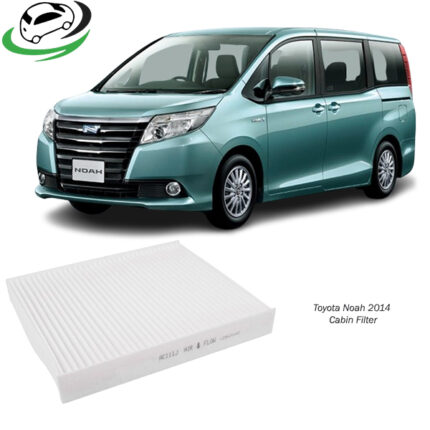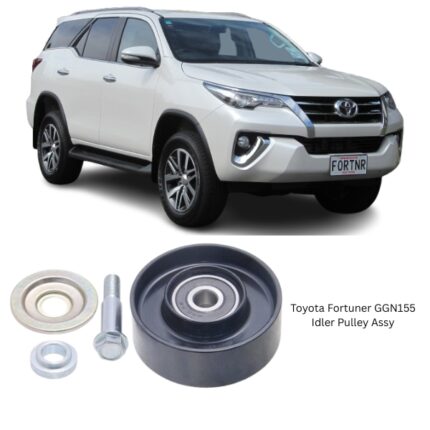Get Lexus RX350 2010-2015 Rear Brake Pad Kit 04466-48130
A rear brake pad kit is an essential part of a vehicle’s braking system. Brake pads work in conjunction with the brake rotors (discs) to provide the necessary friction that helps a vehicle stop when the brakes are applied. While front brake pads typically handle a larger portion of the braking force, rear brake pads are equally important for maintaining overall braking balance, vehicle control, and safety.
This comprehensive guide will explore the structure, types, functions, materials, benefits, and maintenance of rear brake pad kits. It will also cover the signs of wear, replacement procedures, and tips for extending their life.
1. Structure and Components of a Rear Brake Pad Kit
A typical rear brake pad kit consists of several key components that ensure optimal braking performance:
- Brake Pads: The core of the kit, brake pads are friction components that press against the brake rotors when the brake pedal is applied. Each kit typically includes two or four brake pads (depending on the vehicle) to service both rear wheels.
- Shims: Brake shims are thin layers of metal or rubber that sit between the brake pad and the brake caliper. Shims help reduce vibration and noise that can occur during braking.
- Hardware: Some rear brake pad kits come with additional hardware, such as clips, springs, and bolts. These components help hold the brake pads in place and ensure proper alignment, allowing them to function efficiently.
- Wear Sensors: Some kits include electronic wear sensors, which alert the driver when the brake pads are nearing the end of their usable life. These sensors are especially useful for modern vehicles with sophisticated onboard diagnostics.
- Lubricant/Grease: To ensure smooth operation, kits may include special grease or lubricant designed for the brake components. This lubricant reduces friction between the moving parts and helps prevent noise, ensuring longer life for the brake pads and related components.
2. Functions of Rear Brake Pads
While the front brake pads provide most of the stopping force (about 60-70%), the rear brake pads still perform essential functions that contribute to the overall safety and efficiency of the braking system:
- Vehicle Stability: Rear brake pads help maintain vehicle stability during braking, especially in sudden stops or emergency situations. By providing balanced braking force, the rear pads prevent the car from skidding or losing control.
- Parking Brake: In many vehicles, the rear brake pads also function as part of the parking brake system. When the parking brake is applied, it engages the rear pads to hold the vehicle in place, preventing it from rolling.
- Reduced Wear on Front Brakes: By sharing the braking load, rear brake pads reduce the strain on the front brakes. This balance ensures that all components of the braking system wear evenly and last longer.
3. Types of Brake Pads
Brake pads come in various types, each with specific materials and characteristics suited to different driving conditions and vehicle types. The most common types of brake pads include:
- Semi-Metallic Brake Pads: Made from a blend of metal fibers (iron, steel, copper) and synthetic materials, semi-metallic pads offer excellent durability and heat resistance. They perform well under high-stress conditions but can be noisy and produce more brake dust compared to other types.
- Ceramic Brake Pads: Composed primarily of ceramic fibers and bonding agents, ceramic brake pads are known for their quiet operation, low dust output, and long lifespan. They provide consistent braking performance, but they tend to be more expensive than semi-metallic pads.
- Organic (Non-Asbestos Organic, NAO) Brake Pads: Made from a combination of natural materials like rubber, glass, and resins, organic pads offer quieter braking and generate less dust. However, they wear out faster and may not perform as well under high heat or extreme driving conditions.
- Low-Metallic NAO Pads: These pads are similar to organic pads but include small amounts of metal to improve heat transfer and braking performance. They strike a balance between organic and semi-metallic pads in terms of noise, dust, and wear.
Each of these types has its own advantages and disadvantages depending on the driver’s needs, vehicle type, and driving habits.
4. Benefits of Rear Brake Pad Kits
Installing a high-quality rear brake pad kit provides numerous benefits that contribute to vehicle safety, performance, and maintenance:
- Enhanced Braking Performance: A good rear brake pad kit ensures that the vehicle can stop quickly and safely when needed. High-performance brake pads offer consistent braking power, even in demanding driving conditions like heavy traffic or hilly terrain.
- Longer Brake Life: Brake pad kits with premium materials and components help extend the life of the brake pads and rotors. High-quality pads reduce wear on the rotors, preventing costly repairs or replacements.
- Noise Reduction: Shims and other anti-noise components included in many brake pad kits help reduce or eliminate brake noise, such as squealing or grinding. This makes for a quieter and more comfortable driving experience.
- Better Heat Management: Semi-metallic and ceramic pads, in particular, offer excellent heat dissipation, preventing brake fade during long descents or heavy braking situations. Proper heat management ensures that the brakes remain effective even during high-speed or stop-and-go driving.
- Increased Vehicle Safety: Well-maintained rear brake pads contribute to overall vehicle safety by providing balanced braking force. In emergency situations, properly functioning rear pads help shorten stopping distances and prevent accidents.
- Protection Against Corrosion: High-quality brake pad kits often include anti-corrosion coatings on the hardware and components, protecting the braking system from rust and extending its lifespan.
5. Signs of Worn Rear Brake Pads
Like all wear-and-tear components, rear brake pads eventually need to be replaced. Driving with worn brake pads can compromise braking performance and put the driver’s safety at risk. Here are some common signs that your rear brake pads need replacement:
- Squealing or Squeaking Noise: One of the earliest signs of worn brake pads is a high-pitched squealing or squeaking noise when applying the brakes. This is caused by the wear indicator on the brake pads, which is designed to make noise as the pad material thins.
- Grinding Noise: If the brake pads are completely worn down, you may hear a grinding or growling noise when pressing the brake pedal. This noise indicates that the metal backing plate is making contact with the rotor, which can cause serious damage if left unchecked.
- Reduced Braking Performance: Worn brake pads can reduce the vehicle’s ability to stop quickly and safely. If you notice that it takes longer to come to a stop or if the brakes feel less responsive, it’s time to inspect the rear brake pads.
- Vibration When Braking: A pulsating or vibrating sensation in the brake pedal when braking can indicate that the brake pads are worn or that the rotors have become warped due to excessive heat.
- Thin Brake Pads: You can visually inspect the thickness of the rear brake pads by looking through the wheel spokes. If the pads appear to be less than 3mm thick, they should be replaced.
- Brake Warning Light: In vehicles equipped with electronic wear sensors, the brake warning light on the dashboard will illuminate when the rear brake pads are nearing the end of their lifespan.
6. Replacement Procedure for Rear Brake Pads
Replacing rear brake pads is a relatively straightforward process that can be done by a professional mechanic or a skilled DIYer. The following is a general guide for replacing rear brake pads:
- Lift the Vehicle: Use a jack to raise the vehicle and support it with jack stands. Remove the wheels to access the brake calipers.
- Remove the Caliper: Unbolt the brake caliper from its bracket and carefully slide it off the brake rotor. Be sure to hang the caliper using a hanger or bungee cord to avoid damaging the brake hose.
- Remove the Old Pads: Slide the old brake pads out of the caliper bracket. Inspect the rotors for any signs of wear or damage, such as deep grooves or cracks.
- Install the New Pads: Insert the new brake pads into the caliper bracket, ensuring that they are properly aligned. If the kit includes new shims, install them as well.
- Compress the Caliper Piston: Use a brake caliper tool or C-clamp to compress the caliper piston back into its housing. This creates space for the new, thicker brake pads.
- Reinstall the Caliper: Slide the caliper back over the new brake pads and secure it with the bolts. Be sure to torque the bolts to the manufacturer’s specifications.
- Reinstall the Wheels: Put the wheels back on the vehicle and tighten the lug nuts.
- Test the Brakes: Before driving, pump the brake pedal several times to seat the new pads and ensure proper brake pressure. Take the vehicle for a short test drive to confirm that the brakes are functioning correctly.
7. Tips for Extending the Life of Rear Brake Pads
- Drive Smoothly: Avoid hard braking whenever possible. Gradual stops put less strain on the brake pads and rotors, helping them last longer.
- Avoid Overloading the Vehicle: Excessive weight can increase the braking load on the rear pads, causing them to wear out faster. Keep the vehicle’s load within the recommended limits.
- Regular Maintenance: Have your brakes inspected regularly, especially if you notice any signs of wear. Routine maintenance can catch issues before they become serious problems.
- Brake Fluid Maintenance: Ensure that the brake fluid is at the correct level and free from contaminants. Old or dirty brake fluid can affect braking performance and contribute to pad wear.
8. Conclusion
A rear brake pad kit plays a critical role in the safety and performance of a vehicle’s braking system. By understanding the different types, functions, and signs of wear, you can ensure that your brake pads are always in good working condition. Regular maintenance and timely replacement of rear brake pads can help extend their life, protect other components in the braking system, and provide peace of mind on the road. Investing in high-quality brake pad kits is crucial for optimal performance, safety, and driving comfort.
Follow us on Facebook for more parts.





Reviews
Clear filtersThere are no reviews yet.